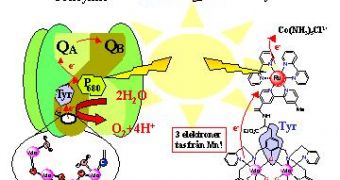In the current international situation, when most of the world's oil resources are on the hands of all kind of fanatic regimes, finding an alternative and renewable solution for oil is of extreme importance.
Researchers at the U.S. Department of Energy's (DOE) Brookhaven National Laboratory focus on the photosynthesis to develop catalysts that would produce fuels (like methanol, methane, and hydrogen) directly from renewable sunlight, water and carbon dioxide.
But photosynthesis is hard to perform in the lab.
The green chlorophyll molecules absorb light whose energy is employed to synthesize energy rich sugars (the plants' food) while oxygen is a byproduct.
But natural photosystems do not work properly outside the cell.
Brookhaven chemists James Muckerman and Dmitry Polyansky have focused on molecular complexes containing metals like ruthenium that can drive the water into oxygen, protons, and electrons.
The ruthenium catalysts keep water molecules in place while protons and electrons pass among the molecules and the catalyst, delivering the charges needed for the photosynthesis to work.
The team is trying to assess the stability and geometry of the molecules employing optical spectroscopy techniques, a difficult task as the intermediate species can be highly unstable, existing for much less than a millisecond. "The catalysts we're using are not necessarily the ultimate catalysts to be used in any practical photosynthetic device. The aim of our work is to understand how theses catalysts work and to elucidate the detailed mechanistic steps so we can design better catalysts," Muckerman said.
A special molecule, NADP+/NADPH coenzyme, is essential in the transport of the protons and electrons employed in the sugars' synthesis. This coenzyme is recyclable in natural photosynthesis, but does not work in the lab, that's why another Brookhaven team is intending to find an NADPH-inspired catalyst. "Using visible light, we want to regenerate hydride donors, where the same molecule will just keep turning over," said chemist Etsuko Fujita.
This team also employs a ruthenium-based complex for their model. Its artificial complex could work similarly to NADP+/NADPH, acting as the source of two electrons and a proton in passing from acetone to isopropanol.
The team is looking on how the hydride donors can be made using light, and wants to employ this artificial catalyst in the production of fuels from carbon dioxide in the future.
Catalysts that turn carbon dioxide (CO2) into carbon monoxide (CO), a good source of fuel, are already developed. ?The problem is that the catalysts are inefficient and slow -- nowhere near efficient enough to use in a practical application," said Brookhaven chemist David Grills.
That's because the liquid solvent employed to dissolve the chemicals inhibits one of the main intermediate species that reacts with CO2.
Grills is focusing on eliminating the use of this solvent by pressurizing and heating up the CO2 (a gas under normal conditions) till it gets some liquid properties and can be used as a good solvent. "Now, our solvent is the reactant and nothing else is getting in the way," said Grills.

 14 DAY TRIAL //
14 DAY TRIAL //